Summary Results of Radon-222 Activity Monitoring in Karst Caves in Bulgaria
Abstract
1. Introduction
- Periodic measurements with portable instruments at fixed points, selected according to the structure of the studied karst geosystems;
- Installation of stationary instrumental equipment for continuous measurements in cave systems and in their adjacent territories;
- Remote uses of the available results of measurements, including from instruments mounted on satellites in orbit around the Earth.
- Interactions between natural radiation processes and modern karstogenesis;
- Connection between radon and seismotectonic activity;
- Radiation protection of workers in karst show caves.
2. Objects of the Study
| Cave and Status 1 | Cave Location | Cave Entrance/s | Cave Dimensions, m | Type of Rock | Cave Morpho- and Hydro-Characteristics 2 |
|---|---|---|---|---|---|
| (Number as per Figure 1) | (v.—Village; c.—City; m.—Municipality) | (height, m a.s.l.) | (total length/denivelation) | (rock age) | |
| MOESIAN PLAIN | Limestone: | ||||
| 1. Magura—ShC (1961); NM (1960) | v.Rabisha, m.Belogradchik | 371/364 | 3645/+44, −25 | (J3-K1) | AC, HC, LC, E-3 (2) // DryC |
| 2. Venetsa—ShC (2015); NM (1971) | v.Oreshets, m.Dimovo | 350 | 220/−28 | (J3-K1) | AC, CC, MC, E-1 (1) // DryC |
| 3. Devetashka Cave—ShC (2013); NM (1996) | v.Devetaki, m.Lovech | 126 | 2442/+96, −25 | (K1) | SC, HC, E-8 // CR and DryC |
| 4. Mandrata | v.Chavdartsi, m.Lovech | 197 | 530/+12 | (K1) | SC, HC, E-1 // DryC and CR |
| 5. Urushka Maara | v.Krushuna, m.Letnitsa | 180 | 1700/+25 | (K1) | SC, HC, MC, E-1 // CR, CL |
| 6. Boninska Dupka | v.Krushuna, m.Letnitsa | 269 | 5550/+33, −22 | (K1) | SC, HC, MC, E-1 // CR, CL |
| 7. Vodopada Cave—in NM (1995) | v.Krushuna, m.Letnitsa | 215 | 2225 | (K1) | SC, HC, LC, E-1 // CR, CL |
| 8. Orlova Chuka—ShC (1942, 1961); NM (1962) | v.Pepelina, m.Dve mogili | 170 | 13,437/+33, −12 | (K1) | AC-SC, HC, LC, E-2 (1) // DryC |
| 9. Bisserna Cave—ShC (2019); in NM (1980) | c.Shumen, m.Shumen | 404/411 | 2716/+19,5 | (K2) | SC, HC, CC, MC, E-2 (1) // CR, CapC |
| STARA PLANINA MOUNTAIN | Limestone: | ||||
| 10. Ledenika—ShC (1961); NM (1960) in NP | c.Vratsa, m.Vratsa | 835 | 320/+16, −21 | (J3) | AC, DC-UC, CC, MC, E-2 // CL, DryC |
| 11. Temnata Dupka—NM (1962) in NP | v.Milanovo, m.Svoge | 398 | 9000/+33, −21 | (T2) | SC, CC, LC, MC, E-1 // DryC and CR, CL |
| 12. Kolkina Dupka | v.Zimevitsa, m.Svoge | 1290 | 24,034/−561 | (T2) | AC, CC, LC, MC, E-1 // DryC and CR |
| 13. Saeva Dupka—ShC (1967); NM (1962) | v.Brestnitsa, m.Yablanitsa | 500 | 230/+3, −17 | (J3-K1) | AC, DC-UC, CC, MC, E-1 // DryC |
| 14. Gradezhnishka Cave—NM (1962) | v.Glogovo, m.Teteven | 456 | 908/+15 | (T-J) | SC, HC, E-2 // CR, CapC |
| 15. Emenska Cave—in NM (1980) | v.Emen, m.Veliko Tarnovo | 249 | 3113/+8, −40 | (K1) | AC, CC, LC, MC, E-1 // DryC and CR |
| 16. Bacho Kiro Cave—ShC (1937); NM (1962) | c.Dryanovo, m.Dryanovo | 350 | 3600/+65 | (K1) | AC-SC, LC, MC, E-1 // DryC |
| 17. Andaka | c.Dryanovo, m.Dryanovo | 250 | 5000/+45 | (K1) | SC, HC, LC, MC, E-1 // CR, CapC |
| UPPER THRACIAN LOWLAND | Limestone: | ||||
| 18. Chirpan Bunar—NM (1974) | v.Granit, m.Bratya Daskalovi | 155 | 445/+3 | (Pg2) | SC, HC, E-2 (1) // CR, CapC |
| STRANDZHA MOUNTAIN | Marbled limestone (J) | ||||
| 19. Labyrinth Cave—in NP (1995) | v.Stoilovo, m.Malko Tarnovo | 263 | 202/−9 | AC, DC, LC, E-1 // DryC | |
| 20. Bazat—in NP (1995) | v.Stoilovo, m.Malko Tarnovo | 265/270 | 58/−5 | AC, HC, E-2 // DryC | |
| 21. Golyamata Vapa—in NP (1995) | v.Stoilovo, m.Malko Tarnovo | 300 | 450/−125 | AC, CC, LC, E-1 // DryC and CR | |
| 22. Varadat—in NP (1995) | v.Stoilovo, m.Malko Tarnovo | 280 | 43/−12 | AC, DC-UC, E-1 // DryC | |
| 23. Brezhanka—in NM(2007) in NP(1995) | v.Mladezhko, m.Malko Tarnovo | 200 | 67/−5 | AC, CC, E-3 // CL | |
| PIRIN MOUNTAIN | Marble (Pt) | ||||
| 24. Abyss No. 9–11—in NtP(1962) | c.Bansko, m.Bansko | 2525 | 2200/−407 | AC, CC, MC, E-2 // DryC | |
| WESTERN RHODOPE MOUNTAINS | Marble (Pt) | ||||
| 25.Yagodinska Cave—ShC (1982); in NM (1971) | v.Yagodina, m.Borino | 990,997/1020 | 10,500/ +36 | AC-SC, CC, LC, MC, E-2 (2) // CR and DryC | |
| 26. Dyavolsko Garlo—ShC (1977); in PL (1963) | v.Trigrad, m.Devin | 1054/1150 | 548/−89 | AC-SC, CC, MC, E-2 (1) // CR | |
| 27. Ukhlovitsa—ShC (1983); NM (1979) | v.Mogilitsa, m.Smolyan | 1040 | 550/−25 | AC, CC, MC, E-1 // DryC | |
| 28. Goloboitsa-1 | v.Koshnitsa, m.Smolyan | 860 | 2145/+22, −44 | SC, HC, MC, E-2 // CR and DryC | |
| 29. Nadarska Cave | v.Nadartsi, m.Smolyan | 1151 | 55/+10 | AC, HC, E-1 // DryC | |
| 30. Lepenitsa—ShC (2010); NM (1962) | c.Rakitovo, m.Rakitovo | 990 | 2000/+21 | SC, HC, MC, E-2 // CR and DryC | |
| 31. Snezhanka—ShC (1966); NM (1961) in BR | c.Peshtera, m.Peshtera | 880 | 348/−18 | AC, DC, MC, E-2 (1) // DryC | |
| 32. Novata/Starata Cave—in BR (1961) | c.Peshtera, m.Peshtera | 550 | 955/+7 | SC, HC, LC, E-2 //DryC and CL | |
| 33. Yubileyna—NM (2003) in BR (1961) | c.Peshtera, m.Peshtera | 580 | 814/+3, −18 | AC, MC, E-1 //DryC and CR | |
| 34. Gargina Dupka—in NM (2003) | v.Mostovo, m.Asenovgrad | 940 | 525/+38 | SC, CC, MC, E-2 // CR and DryC | |
| 35. Ivanova Voda—in PL (1980) | v.Dobrostan, m.Asenovgrad | 1337 | 695/−113 | AC, CC, E-1 // CL | |
| 36. Topchika—NM (1970) in BP (1962) | v.Dobrostan, m.Asenovgrad | 982 | 727/−61 | AC, CC, MC, E-1 // DryC | |
| 37. Chelevechnitsa | v.Orehovo, m.Chepelare | 1130 | 329/+3, −12 | AC, DC, E-1 // DryC |
3. Methods
- Passive detectors (cumulative, with a longer exposure period, usually up to several months). The results are reported with some delay (transportation, treatment and evaluation of detectors).
- Instrumental (active) devices (discrete, short-term, from several hours to several days, or continuous monitoring, from several months to several years and more). Data is obtained instantaneously (in situ or on-line).
3.1. Passive Measurements of Radon Activity Concentration
3.2. Instrumental Measurements of Radon Activity Concentration
3.3. Comparison Between Passive and Instrumental Measurements of Radon Activity Concentration
4. Results and Discussion
4.1. Concentrations and Regime of Radon Activity in the Studied Caves
4.2. Role of Cave Ventilation in Radon Emissions
4.3. Diurnal Variations in Radon Activity Concentration
4.4. Relationships Between Radon in Soil and in Cave Systems
4.5. Global Changes and Radon Emissions in Cave Systems
4.6. Radon Emissions in Caves as Precursors of Seismotectonic Activity
4.7. Radiation Risk in Show Caves and Individual Effective Doses
5. Conclusions
Author Contributions
Funding
Data Availability Statement
Acknowledgments
Conflicts of Interest
References
- Bulgarian Speleology Federation. Card File of the Caves. Available online: https://caves.speleo-bg.org (accessed on 1 July 2025).
- Andreychouk, V.; Stefanov, P. Some methodological remarks concerning of karst studies from the system approach perspective. Probl. Geogr. 2021, 1, 12–24. [Google Scholar] [CrossRef]
- Stefanov, P.; Stefanova, D.; Nojarov, P. The integrated monitoring of karst systems (MIKS) model applied in karst studies in Bulgaria. Int. J. Speleol. 2025, 54, 1. [Google Scholar] [CrossRef]
- Nojarov, P.; Stefanov, P.; Stefanova, D.; Jelev, G. Climate change, anthropogenic pressure, and sustainable development of karst geosystems (A case study of the Brestnitsa karst geosystem in Northern Bulgaria). Sustainability 2024, 16, 6657. [Google Scholar] [CrossRef]
- Experimental Laboratory of Karstology (ELK) at NIGG-BAS. Available online: http://www.prokarstterra.bas.bg/lab/EN/index.html (accessed on 1 July 2025).
- Cigna, A.A. Radon in caves. Int. J. Speleol. 2005, 34, 1–18. [Google Scholar] [CrossRef]
- UNSCEAR. Sources and Effects of Ionizing Radiation; Report to the General Assembly; UN Publications: New York, NY, USA, 2000. [Google Scholar]
- Sainz, C.; Rábago, D.; Fernández, E.; Quindós, J.; Quindós, L.; Fernández, A.; Fuente, I.; Arteche, J.L.; Quindós, L.S.; Celaya, S. Variations in radon dosimetry under different assessment approaches in the Altamira Cave. J. Radiol. Prot. 2020, 40, 367–380. [Google Scholar] [CrossRef]
- Ševc, J.; Kunz, E.; Plaček, V. Lung-cancer in uranium miners and long-term exposure to radon daughter products. Health Phys. 1976, 30, 433–437. [Google Scholar]
- WHO. Radon and Health. Available online: https://www.who.int/news-room/fact-sheets/detail/radon-and-health (accessed on 1 July 2025).
- Stefanov, P.; Stefanova, D.; Turek, K. Microclimatic and radiation conditions and human health risks in show caves in Bulgaria (based on the results of integrated monitoring). Probl. Geogr. 2020, 3, 47–100. (In Bulgarian) [Google Scholar] [CrossRef]
- ICRP. Radiological Protection Against Radon Exposure; ICRP Publication 126. Ann. ICRP 43(3); Elsevier: Oxford, UK, 2014. [Google Scholar]
- Regulation on Radiation Protection, Adopted by CM Decree No. 20/14.02.2018, Amended by CM No. 455/22.12.2020. Available online: https://bnra.bg/en/document/naredbi/ (accessed on 1 July 2025).
- Stefanov, P.; Nojarov, P.; Turek, K.; Stefanova, D. Global changes and tourism in show caves in Bulgaria—Hazards and relationships. In Proceeding of the 3rd International Conference on Environmental Protection and Disaster Risks (EnviroRISKs 2024); Dobrinkova, N., Fidanova, S., Eds.; Springer Nature: Cham, Switzerland, 2025; pp. 126–138. [Google Scholar] [CrossRef]
- Cunningham, K.I.; Larock, E.J. Recognition of microclimate zones through radon mapping, Lechuguilla Cave, Carlsbad caverns national park, New Mexico. Health Phys. 1991, 61, 493–500. [Google Scholar] [CrossRef] [PubMed]
- Batiot-Guilhe, C.; Seidel, J.L.; Jourde, H.; Hébrard, O.; Bailly-Comte, V. Seasonal variations of CO2 and 222Rn in a Mediterranean sinkhole–spring (Causse d’Aumelas, SE France). Int. J. Speleol. 2007, 36, 51–56. [Google Scholar] [CrossRef]
- Kowalczk, A.J.; Froelich, P.N. Cave air ventilation and CO2 outgassing by Radon-222 modeling: How fast do caves breathe? Earth Planet. Sci. Lett. 2010, 289, 209–219. [Google Scholar] [CrossRef]
- Kávási, N.; Somlai, J.; Szeiler, G.; Szabó, B.; Schafer, I.; Kovács, T. Estimation of effective doses to cavers based on radon measurements carried out in seven caves of the Bakony Mountains in Hungary. Radiat. Meas. 2010, 45, 1068–1071. [Google Scholar] [CrossRef]
- Gregorič, A.; Zidanšek, A.; Vaupotič, J. Dependence of radon levels in Postojna Cave on outside air temperature. Nat. Hazards Earth Syst. Sci. 2011, 11, 1523–1528. [Google Scholar] [CrossRef]
- Smetanová, I.; Holý, K.; Luhová, Ľ.; Csicsay, K.; Haviarová, D.; Kunáková, L. Seasonal variation of radon and CO2 in the Važecká Cave, Slovakia. NUKLEONIKA 2020, 65, 153–157. [Google Scholar] [CrossRef]
- Perrier, F.; Patrick Richon, P. Spatiotemporal variation of radon and carbon dioxide concentrations in an underground quarry: Coupled processes of natural ventilation, barometric pumping and internal mixing. J. Environ. Radioact. 2024, 101, 279–296. [Google Scholar] [CrossRef]
- Tang, W.; Yin, J.-J.; Lan, G.; Yang, H.; Wu, X. Dynamic variation characteristicx of 222Rn in typical karst cave systems in south China and their influencing factors. J. Environ. Radioact. 2025, 289, 107748. [Google Scholar] [CrossRef]
- Fijałkowska–Lichwa, L.; Tyc, A.; Przylibski, T.A. Radon (222Rn) as a tracer of cave air exchange. Air Qual. Atmos. Health 2025, 18, 867–897. [Google Scholar] [CrossRef]
- Fernandez, P.L.; Quindos, L.S.; Soto, J.; Villar, E. Radiation exposure levels in Altamira Cave. Health Phys. 1984, 46, 445–447. [Google Scholar]
- Vaupotič, J.; Csige, I.; Radolić, V.; Hunyadi, I.; Planinić, J.; Kobal, I. Methodology of radon monitoring and dose estimates in Postojna Cave, Slovenia. Health Phys. 2001, 80, 142–147. [Google Scholar] [CrossRef]
- Lario, J.; Sánchez-Moral, S.; Cañaveras, J.C.; Cuezva, S.; Soler, V. Radon continuous monitoring in Altamira Cave (northern Spain) to assess user’s annual effective dose. J. Environ. Radioact. 2005, 80, 161–174. [Google Scholar] [CrossRef]
- Sainz, C.; Quindós, L.S.; Fuente, I.; Nicolás, J.; Quindós, L. Analysis of the main factors affecting the evaluation of the radon dose in workplaces: The case of tourist caves. J. Hazard. Mater. 2007, 145, 368–371. [Google Scholar] [CrossRef]
- Field, M.S. Risks to cavers and cave workers from exposures to low-level ionizing a radiation from 222Rn decay in caves. J. Cave Karst Stud. 2007, 69, 207–228. [Google Scholar]
- Thinova, L.; Rovenska, K. Radon dose calculation methodology for underground workers in the Czech Republic. Radiat. Prot. Dosim. 2011, 145, 233–237. [Google Scholar] [CrossRef]
- Nagy, H.E.; Szabó, Z.; Jordán, G.; Szabó, C.; Horváth, Á.; Kiss, A. Time variations of 222Rn concentration and air exchange rates in a Hungarian cave. Isot. Environ. Health Stud. 2012, 48, 464–472. [Google Scholar] [CrossRef]
- Ates, A.; Comlek, U.; Uslu, I.; Kaya, B. Investigation of radon level in Tinaztepe Cave (Konya/Turkey). Energy Sci. Res. 2013, 31, 47–56. [Google Scholar]
- Özen, S.A.; Çevik, U.; Taşkin, H. Comparison of active and passive radon survey in cave atmosphere, and estimation of the radon exposed dose equivalents and gamma absorbed dose rates. Isot. Environ. Health Stud. 2018, 55, 92–109. [Google Scholar] [CrossRef]
- Burghele, B.D.; Cucos, A.; Papp, B.; Stetca, F.A.; Mirea, I.; Constantin, S. Distribution of radon gas in Romanian show caves and radiation safety. Radiat. Prot. Dosim. 2018, 181, 1–5. [Google Scholar] [CrossRef] [PubMed]
- Yamada, R.; Tamakuma, Y.; Suzuki, T.; Nakasone, S.; Shiroma, Y.; Furukawa, M.; Hashimoto, H.; Hosoda, M.; Akata, N.; Tokonami, S. A preliminary study of radon equilibrium factor at a tourist cave in Okinawa, Japan. Atmosphere 2021, 12, 1648. [Google Scholar] [CrossRef]
- Varbanov, P.; Velikov, V.; Vasilev, G. A study on the radioactivity of caves in Bulgaria. Hyg. Healthc. 1975, XVIII, 491–495. (In Bulgarian) [Google Scholar]
- Pressyanov, D. Modeling a 222Rn measurement technique based on absorption in polycarbonates and track-etch counting. Health Phys. 2009, 97, 604–612. [Google Scholar] [CrossRef]
- Nojarov, P. Genetic climatic regionalization of the Balkan Peninsula using cluster analysis. J. Geogr. Sci. 2017, 27, 43–61. [Google Scholar] [CrossRef]
- Nojarov, P.; Stefanov, P.; Turek, K. Influence of some climatic elements on radon concentration in Saeva Dupka Cave, Bulgaria. Int. J. Speleol. 2020, 49, 235–248. [Google Scholar] [CrossRef]
- Beron, P.; Daaliev, T.; Zhalov, A. Caves and Speleology in Bulgaria; Bulgarian Federation of Speleology and National Museum of Natural History, Pensoft: Sofia, Bulgaria, 2006; 508p. [Google Scholar]
- Durrani, S.A.; Bull, R.K. Solid State Nuclear Track Detectors; Pergamon Press: Oxford, UK, 1987. [Google Scholar]
- Paar, D.; Buzjak, N.; Bakšić, D.; Radolić, V. Physical research in Croatia’s deepest cave system: Lukina jama-Trojama, Mt. Velebit. Jama. In Proceedings of the 16th International Congress of Speeleology, Brno, Czech Republic, 21–28 July 2013; Folipi, M., Bosak, P., Eds.; Czech Speleological Society: Kladno, Prague, 2013; Volume 2, pp. 442–446. [Google Scholar]
- Tomassino, L. Solid dielectric detectors with breakdown phenomena and their application in radioprotection. Nucl. Instr. Meth. 1980, 173, 73–83. [Google Scholar] [CrossRef]
- National Institute for Nuclear, Chemical and 513 Biological Protection, Kamenná near Příbram, Czech Republic. Available online: http://www.sujchbo.cz/ (accessed on 1 July 2025).
- ImageJ. Available online: http://rsbweb.nih.gov/ij/download.html (accessed on 1 July 2025).
- Turek, K.; Gelev, M.; Dimov, I. Comparative measurements of soil gas radon concentration using thermoluminescent and track detectors. Radiat. Meas. 2004, 38, 843–846. [Google Scholar] [CrossRef]
- METER.AC. Available online: https://meter.ac/gs/earth/html/current.html (accessed on 1 July 2025).
- The UIS Cave and Karst Glossary. Available online: http://uisic.uis-speleo.org/uisglossary-en.html (accessed on 1 July 2025).
- Suchkov, D.; Sinnyovsky, D. The canyon of Dryanovo river, Gabrovo district. In Annual of the University of Mining and Geology “St. Ivan Rilski”; St. Ivan Rilski: Sofia, Bulgaria, 2010; Volume 53, pp. 119–124. (In Bulgarian) [Google Scholar]
- Jakucs, L. Morphogenetics of Karst Regions. Variants of Karst Evolution; Akademiai Kiado: Budapest, Hungary, 1977; 284p. [Google Scholar]
- Kozhuharov, D.; Dimitrova, R.; Kozhuharova, E.; Katskov, N. Explanatory Note to the Geological Map of Bulgaria, M 1:100,000, Map Sheet Dospat; “Geology and Geophysics” Ltd.: Sofia, Bulgaria, 1993; 47p. (In Bulgarian) [Google Scholar]
- Pla, C.; Ruiz, M.; Gill-Oncina, S.; García-Martinez, N.; Cañaveras, J.C.; Cuezva, S.; Fernández-Cortés, Á.; Sánchez-Moral, S.; Benavente, D. 222Rn and CO2 monitoring in soil and indoor atmosphere to understand changes in the gaseous dynamics of Rull cave (Spain). Environ. Earth Sci. 2023, 82, 235. [Google Scholar] [CrossRef]
- Kunovska, B.; Ivanova, K.; Djunakova, D.; Chobanova, N.; Djounova, J.; Stojanovska, Z. Continuous diurnal radon measurements in Bulgarian caves and dose assessment. Eur. Phys. J. Spec. Top. 2023, 232, 1617–1623. [Google Scholar] [CrossRef]
- Nojarov, P. Climate and its changes in the period 1979–2018 in selected model karst regions in Bulgaria. Probl. Geogr. 2020, 3, 11–28. [Google Scholar] [CrossRef]
- Copernicus Climate Change Service (C3S): ERA5-Land Monthly Averaged Data from 1950 to Present. Copernicus Climate Change Service (C3S) Climate Data Store (CDS). 2022. Available online: https://cds.climate.copernicus.eu/datasets/reanalysis-era5-land-monthly-means?tab=overview (accessed on 10 April 2025).
- Oh, Y.; Kim, G. A radon-thoron isotope pair as a reliable earthquake precursor. Sci. Rep. 2015, 5, 13084. [Google Scholar] [CrossRef] [PubMed]
- Taheri, M.; Baradaran, S.; Jafarizadeh, M. Increased radon concentration in Katalekhor tourist cave during an earthquake compared with 10 years of follow-up data. J. Radioanal. Nucl. Chem. 2020, 326, 911–918. [Google Scholar] [CrossRef]
- Petraki, E.; Nikolopoulos, D.; Panagiotaras, D.; Cantzos, D.; Yannakopoulos, P.; Nomicos, C.; Stonham, J. Radon-222: A Potential Short-Term Earthquake Precursor. J. Earth Sci. Clim. Change 2015, 6, 282. [Google Scholar] [CrossRef]
- D’Incecco, S.; Petraki, E.; Priniotakis, G.; Papoutsidakis, M.; Yannakopoulos, P.; Nikolopoulos, D. CO2 and Radon Emissions as Precursors of Seismic Activity. Earth Syst. Environ. 2021, 5, 655–666. [Google Scholar] [CrossRef]
- Stefanov, P.; Turek, K.; Svetlik, I.; Briestensky, M. Radon and fault displacements in Bacho Kiro cave (Bulgaria) related to closely situated earthquakes. In Proceedings of the 5th International Scientific Conference “Geographical Sciences and Education”, Shumen, Bulgaria, 4–5 November 2016; University Press “Episkop Konstantin Preslavski”: Shumen, Bulgaria, 2017; pp. 49–56. [Google Scholar]
- Tirmarche, M.; Harrison, J.D.; Laurier, D.; Paquet, F.; Blanchardon, E.; Marsh, J.W. Lung Cancer Risk from Radon and Progeny and Statement on Radon; ICRP Publication 115, Ann. ICRP 40(1); Elsevier: Oxford, UK, 2010. [Google Scholar]
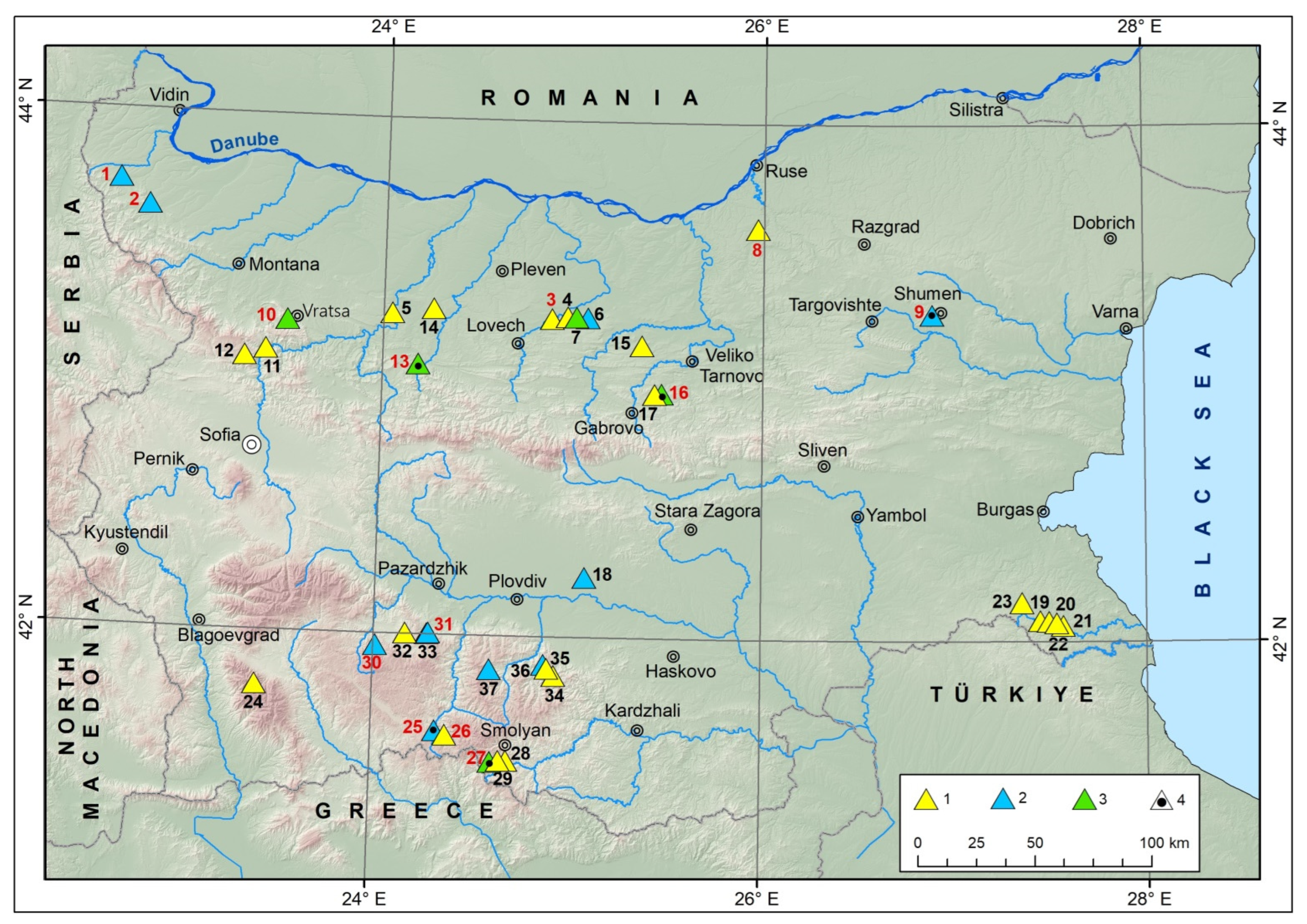
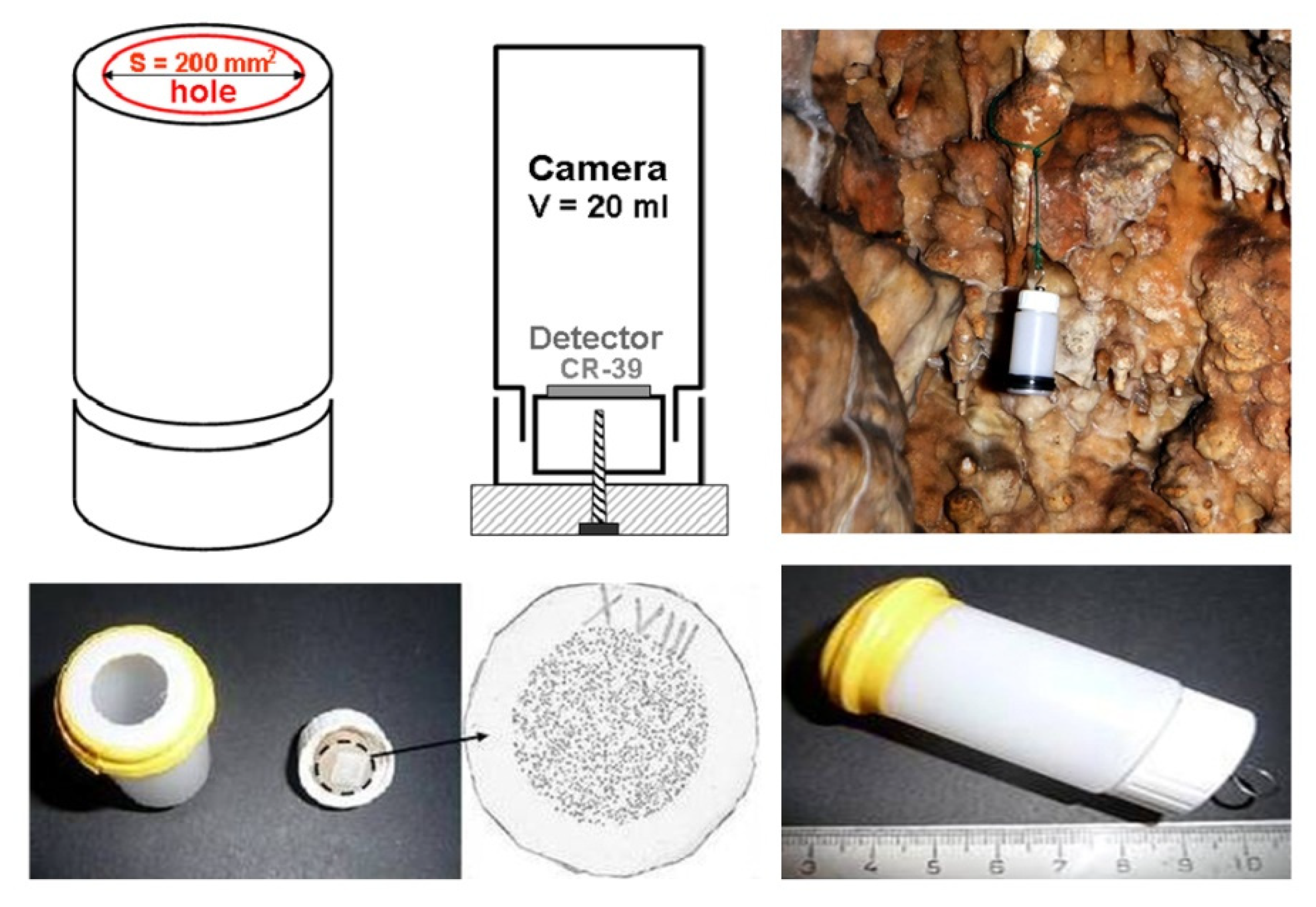
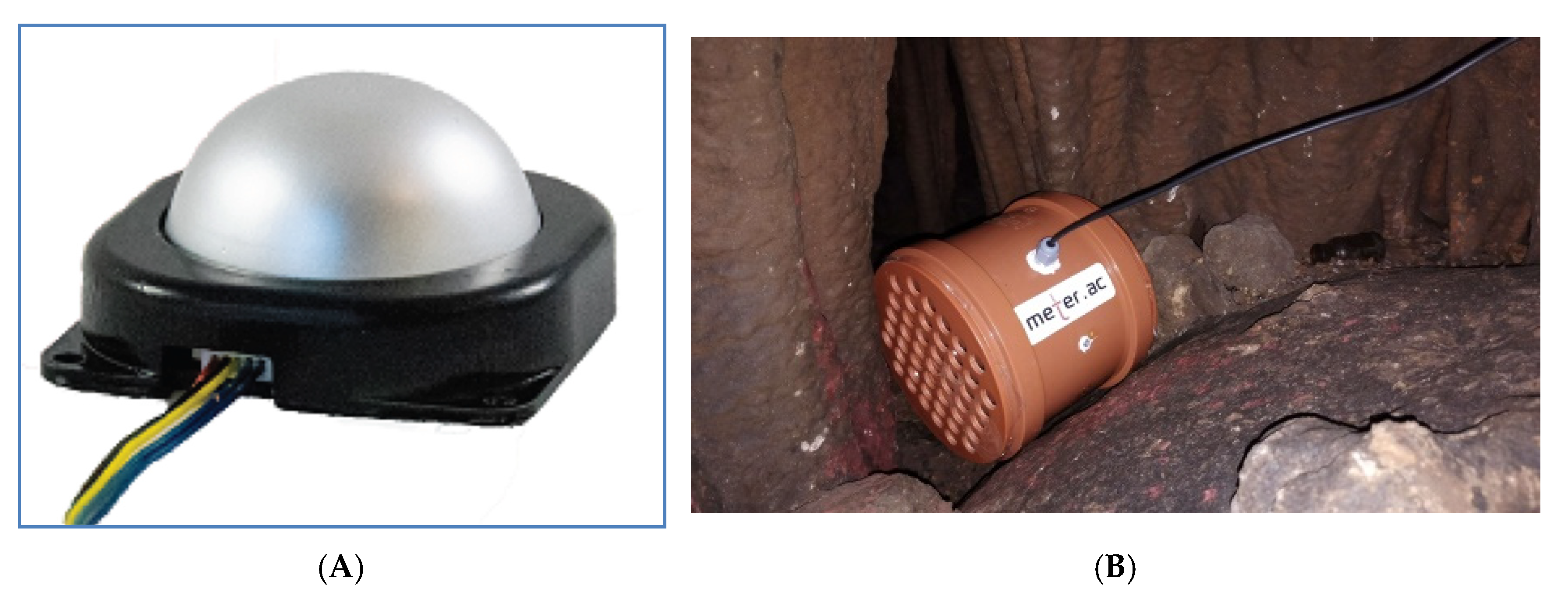
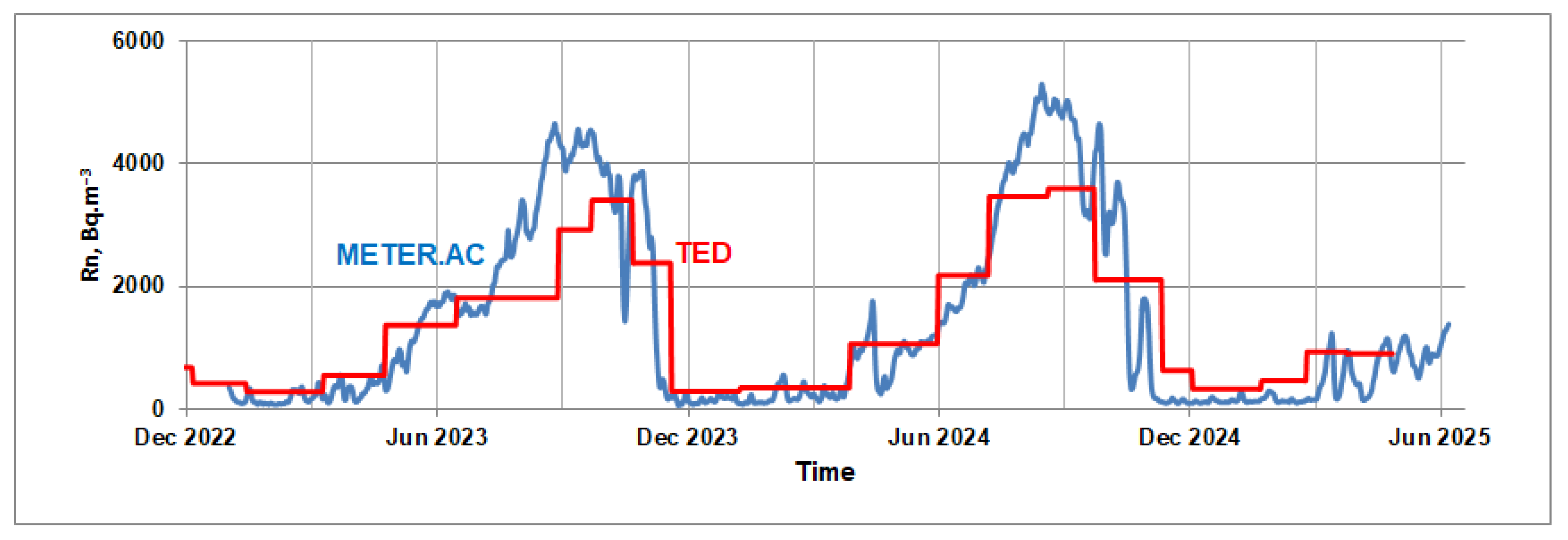

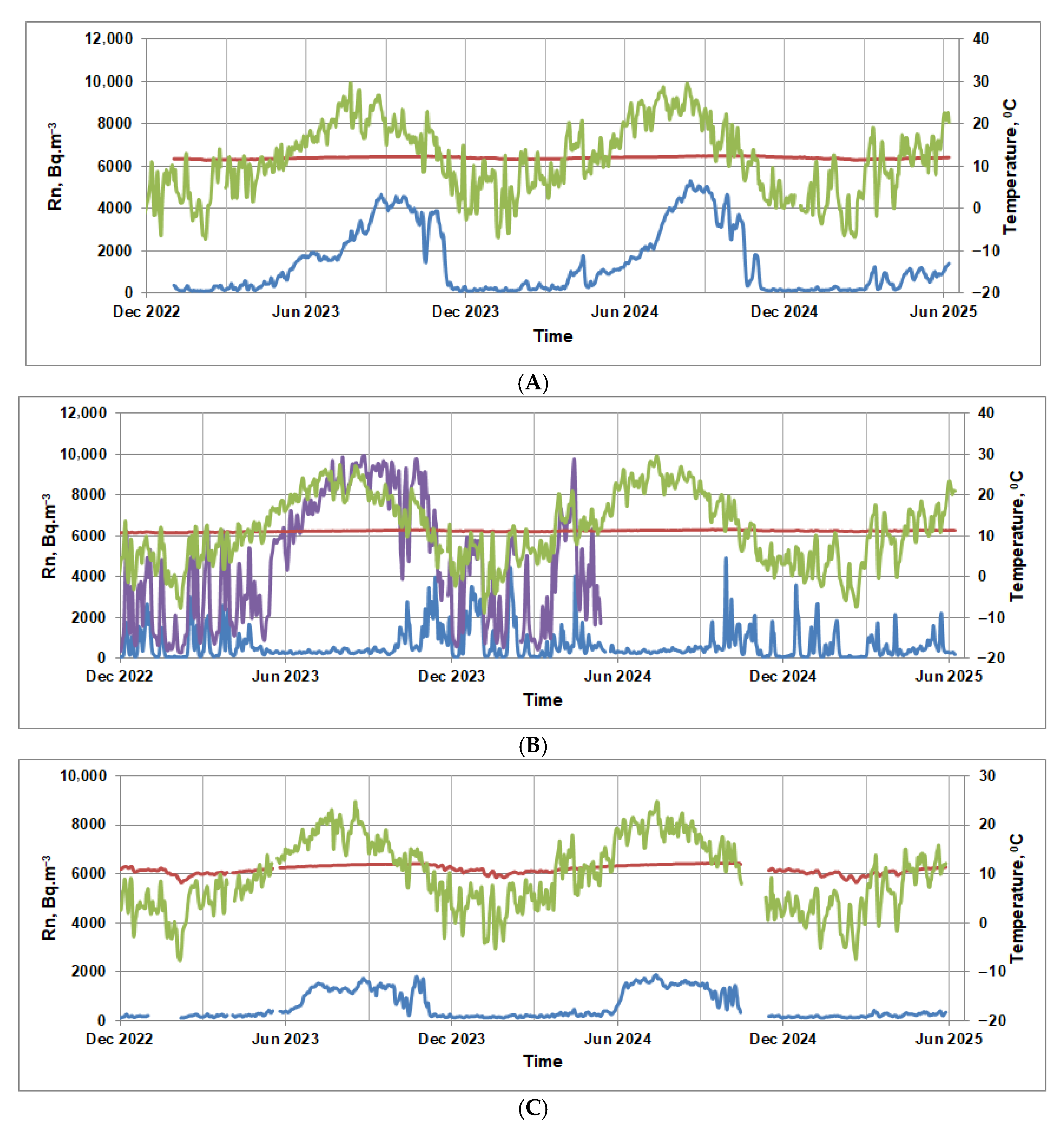
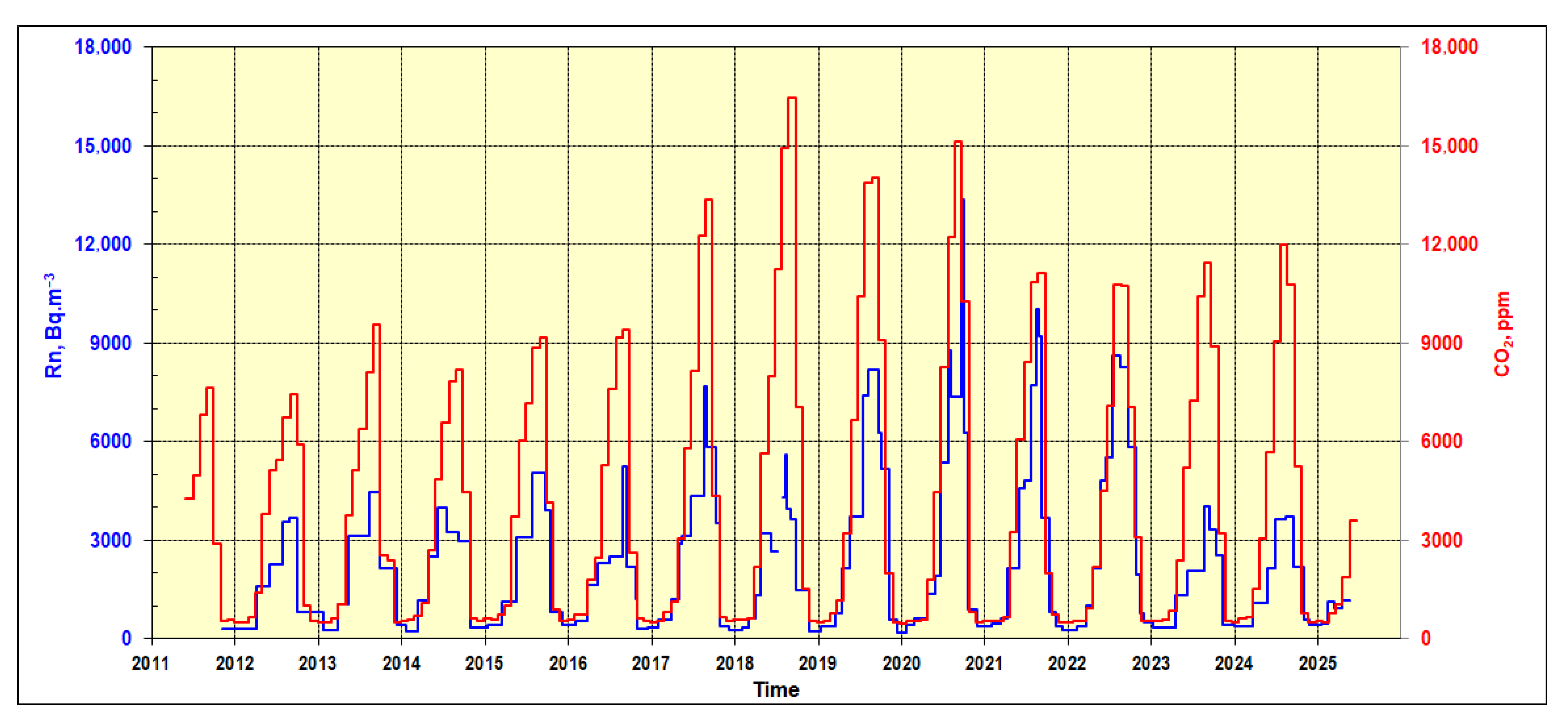
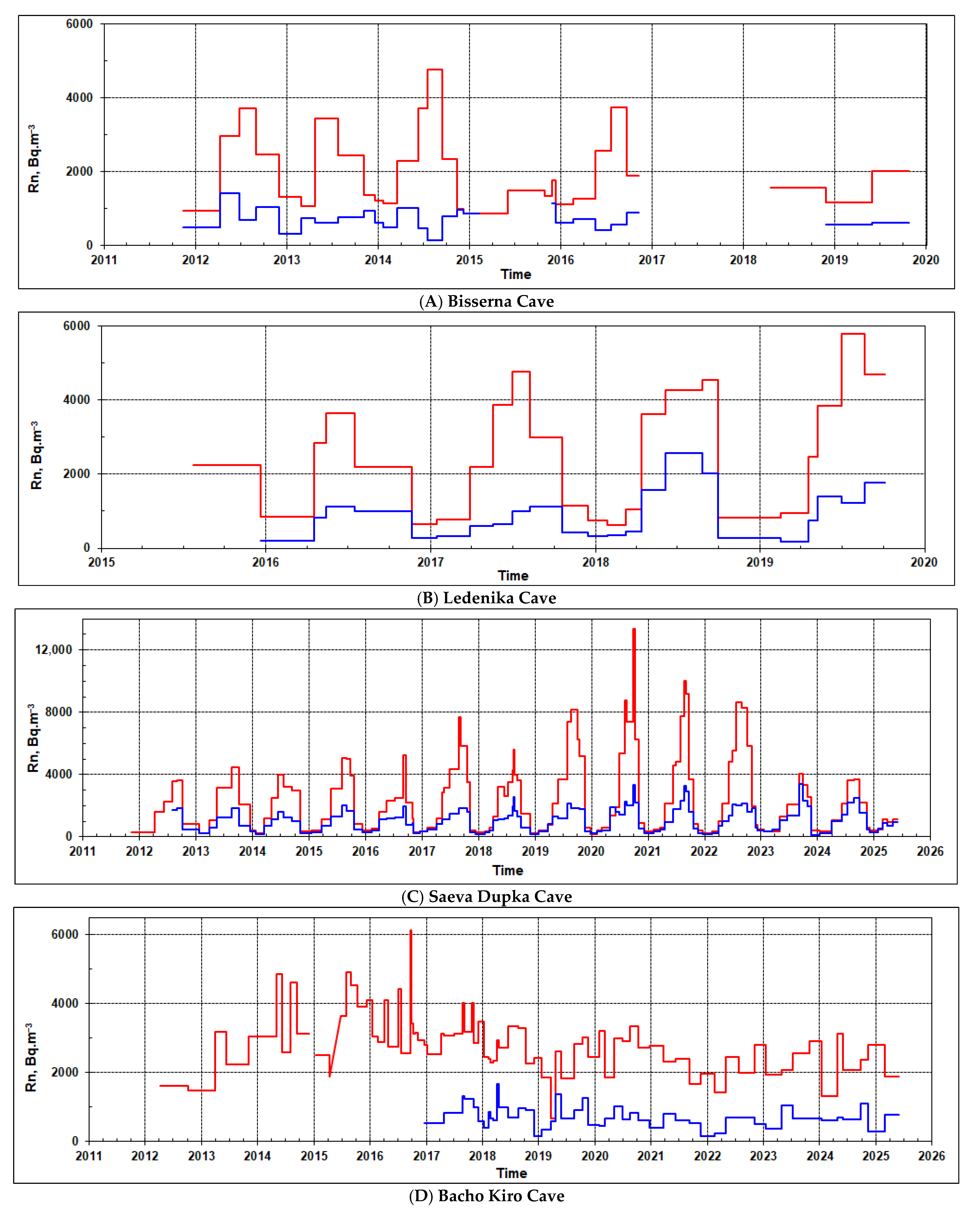

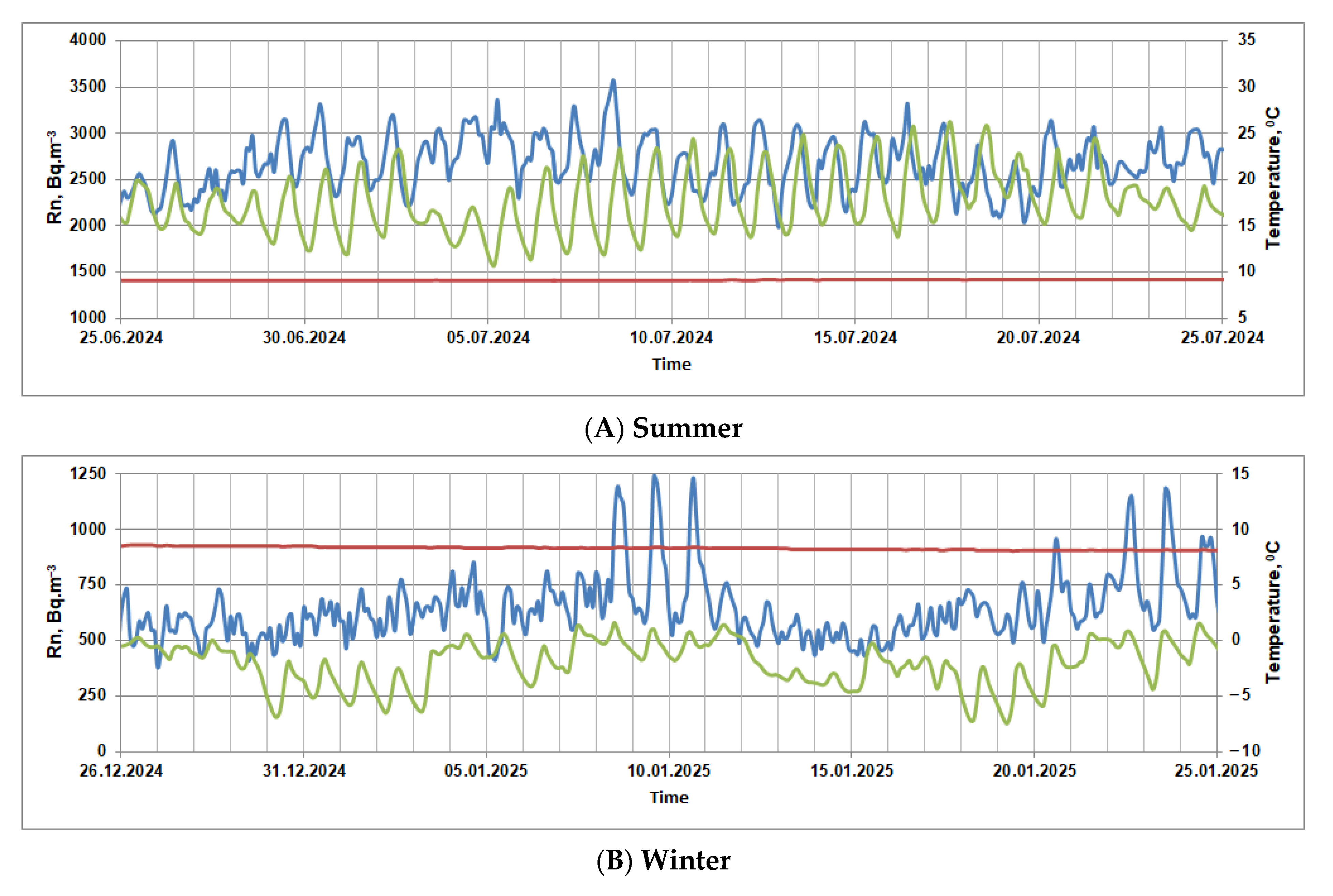
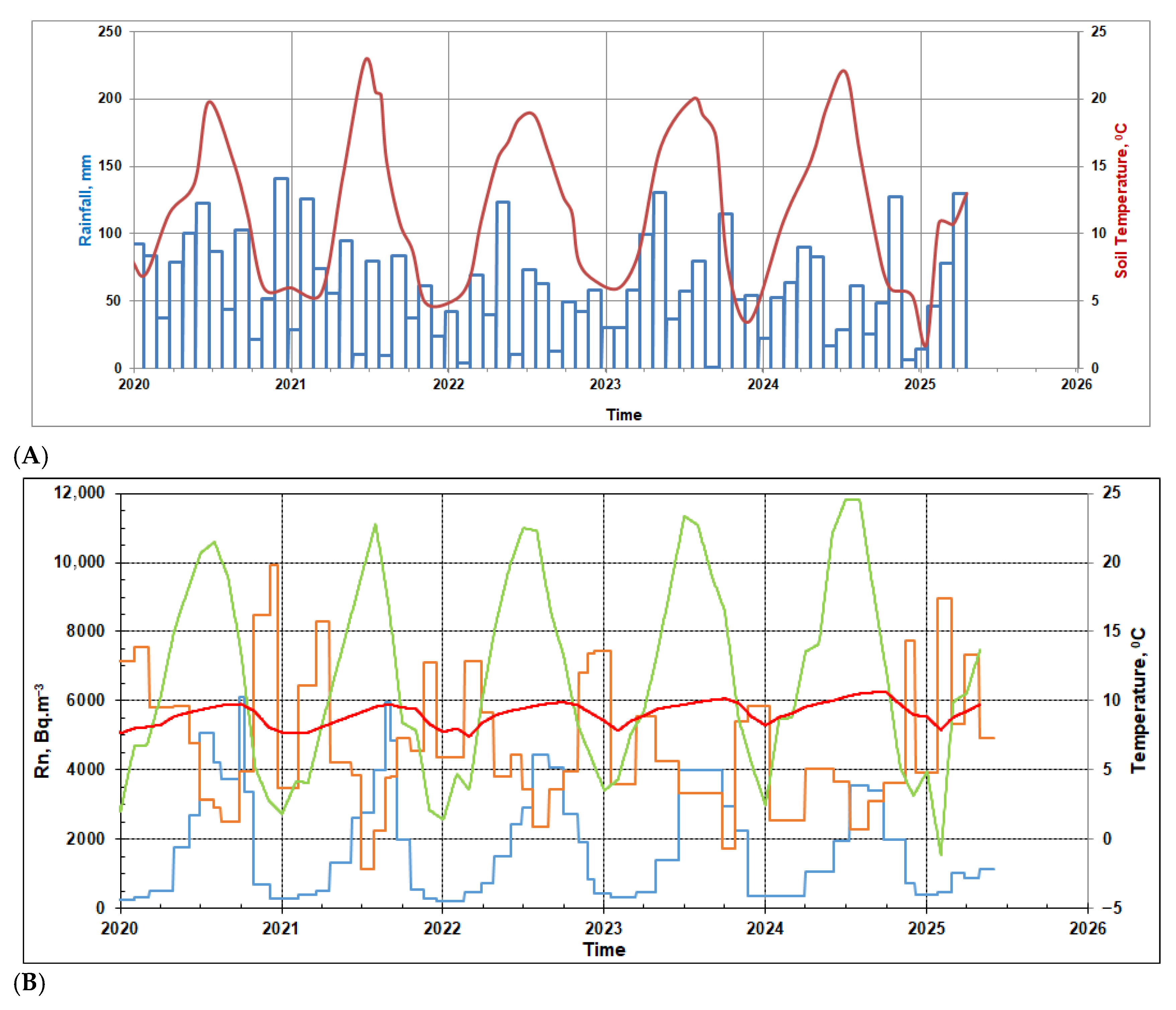

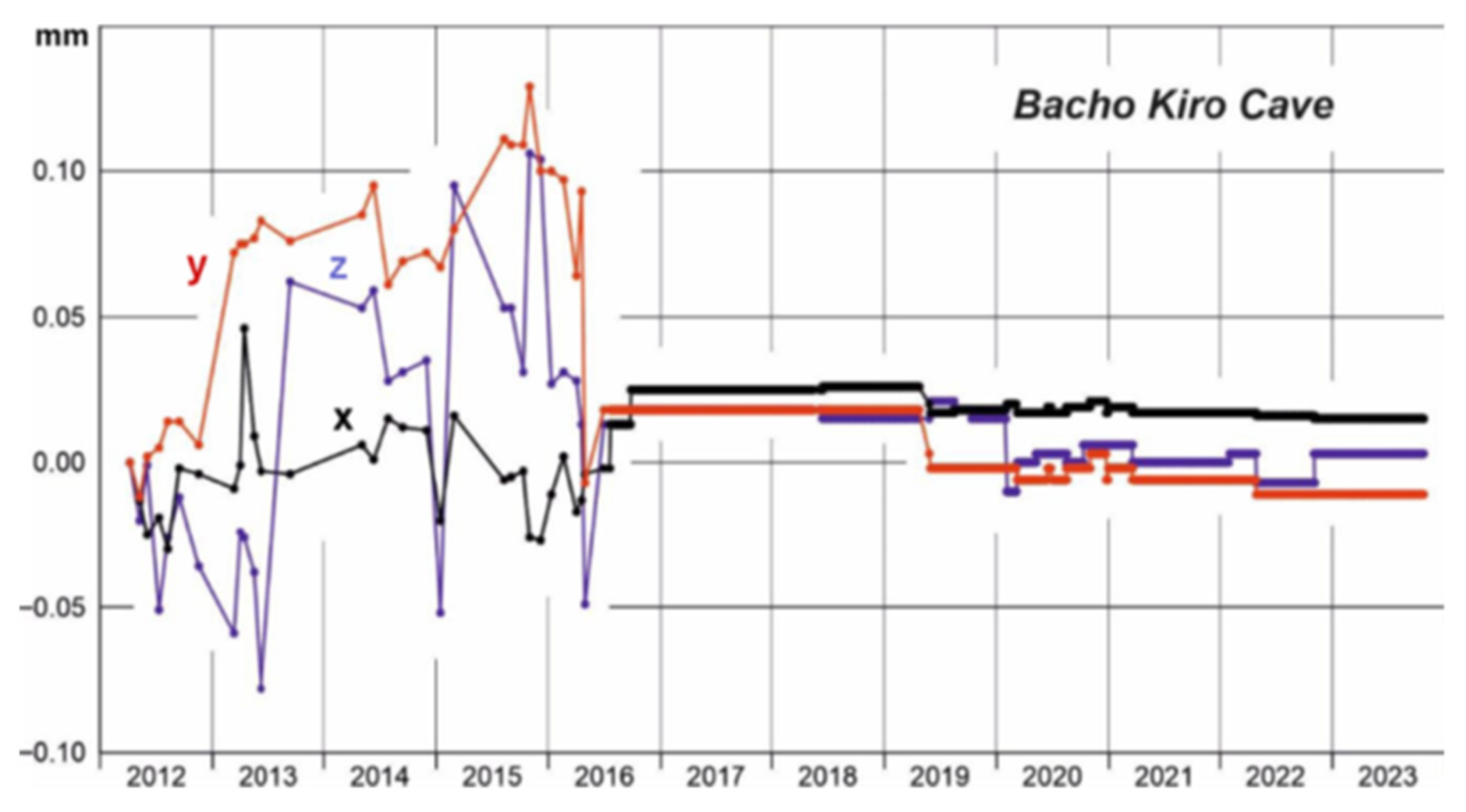
| Cave (Number as per Figure 1) | Cave Monitoring Point | Cave Climatic Zone | Time | Concentration Lowest | Highest | Annual Average |
|---|---|---|---|---|---|---|
| Years | Bq.m−3 | Bq.m−3 | Bq.m−3 | |||
| MOESIAN PLAIN | ||||||
| 1. Magura | point 1 | Transitional | 2.7 | 423 | 687 | 569 |
| point 2 | Internal | 5.4 | 397 | 982 | 640 | |
| 2. Venetsa | point 1 (Office) | Entrance zone | 5.0 | 124 | 3472 | 897 |
| point 2 | Transitional | 5.7 | 145 | 6887 | 2177 | |
| point 3 | Internal | 5.6 | 202 | 4459 | 1830 | |
| 3. Devetashka Cave | point 1 | Transitional | 2.2 | 94 | 184 | 111 |
| 4. Mandrata | point 1 | Transitional | 3.8 | 87 | 330 | 169 |
| 5. Urushka Maara | point 1 | Transitional | 2.4 | 236 | 420 | 327 |
| 6. Boninska Cave | point 1 | Transitional | 2.3 | 337 | 2158 | 621 |
| point 2 | Internal | 6.5 | 897 | 2678 | 1470 | |
| 7. Vodopada Cave | point 1 | Transitional | 5.5 | 189 | 5973 | 1169 |
| point 2 | Internal | 11.4 | 204 | 7774 | 1212 | |
| 8. Orlova Chuka | point 1 | Transitional | 4.5 | 507 | 1939 | 1247 |
| point 2 | Internal | 2.3 | 927 | 3224 | 1805 | |
| point 3 | Internal | 2.1 | 738 | 3012 | 1716 | |
| 9. Bisserna Cave | point 1 | Transitional | 5.9 | 130 | 1971 | 677 |
| point 2 | Internal | 6.5 | 317 | 5903 | 1889 | |
| point 3 | Internal | 3.9 | 748 | 3839 | 1518 | |
| STARA PLANINA MOUNTAIN | ||||||
| 10. Ledenika | point 1 | Transitional | 10.7 | 167 | 2559 | 572 |
| point 2 | Internal | 5.8 | 163 | 2591 | 534 | |
| point 3 | Internal | 5.6 | 264 | 5783 | 2432 | |
| 11. Temnata Dupka | point 1 | Transitional | 1.9 | 460 | 1516 | 788 |
| 12. Kolkina Dupka | point 1 (−112 m) | Transitional | 1.5 | 893 | 3515 | 1383 |
| point 2 (−213 m) | Internal | 1.5 | 795 | 2385 | 1090 | |
| point 3 (−267 m) | Internal | 1.2 | 895 | 1900 | 1101 | |
| 13. Saeva Dupka | point 1 (outside) | Entrance zone | 10.1 | 8 | 200 | 38 |
| point 2 | Transitional | 12.8 | 104 | 3382 | 984 | |
| point 3 | Transitional | 12.6 | 112 | 4061 | 1284 | |
| point 4 | Internal | 13.5 | 176 | 13,376 | 1792 | |
| point 5 | Internal | 13.5 | 167 | 4231 | 1214 | |
| 14. Gradezhnishka Cave | point 1 | Transitional | 1.7 | 314 | 1466 | 1111 |
| 15. Emenska Cave | point 1 | Transitional | 4.2 | 104 | 862 | 416 |
| 16. Bacho Kiro Cave | point 1 | Transitional | 8.2 | 168 | 1677 | 672 |
| point 2 | Internal | 8.5 | 177 | 3118 | 493 | |
| point 3 | Internal | 11.2 | 676 | 3949 | 1723 | |
| point 4 | Internal | 12.6 | 629 | 6136 | 2472 | |
| 17. Andaka | point 1 | Transitional | 2.4 | 137 | 1250 | 761 |
| UPPER THRACIAN LOWLAND | ||||||
| 18. Chirpan Bunar | point 1 | Transitional | 5.7 | 548 | 2917 | 1035 |
| STRANDZHA MOUNTAIN | ||||||
| 19. Labyrinth Cave | point 1 | Internal | 1.6 | 460 | 7937 | 3851 |
| 20. Bazat | point 1 | Transitional | 2.0 | 127 | 785 | 253 |
| 21. Golyamata Vapa | point 1 | Internal | 3.1 | 443 | 5677 | 2758 |
| 22. Varadat | point 1 | Internal | 2.9 | 224 | 5999 | 1567 |
| 23. Brezhanka | point 1 | Transitional | 2.0 | 164 | 4027 | 1008 |
| PIRIN MOUNTAIN | ||||||
| 24. Abyss No. 9–11 | point 1 | Transitional | 1.0 | 177 | 177 | 177 |
| point 2 | Transitional | 1.0 | 219 | 219 | 219 | |
| point 3 | Internal | 1.0 | 312 | 312 | 312 | |
| WESTERN RHODOPE MOUNTAIN | ||||||
| 25. Yagodinska Cave | point 1 | Transitional | 6.1 | 560 | 1961 | 940 |
| point 2 | Transitional | 6.1 | 437 | 1853 | 827 | |
| 26. Dyavolsko Garlo | point 1 | Transitional | 4.2 | 84 | 132 | 107 |
| point 2 | Transitional | 4.2 | 44 | 248 | 93 | |
| 27. Ukhlovitsa | point 1 | Transitional | 10.3 | 102 | 1922 | 717 |
| point 2 | Internal | 10.6 | 162 | 2112 | 723 | |
| 28. Goloboitsa | point 1 | Internal | 2.0 | 358 | 934 | 433 |
| point 2 | Internal | 2.0 | 334 | 702 | 469 | |
| 29. Nadarska Cave | point 1 | Transitional | 2.1 | 66 | 595 | 324 |
| 30. Lepenitsa | point 1 | Internal | 8.1 | 365 | 2943 | 1139 |
| point 2 | Internal | 8.3 | 376 | 4280 | 1492 | |
| 30. Lepenitsa | point 1 | Internal | 8.1 | 365 | 2943 | 1280 |
| point 2 | Internal | 8.3 | 376 | 4280 | 1369 | |
| 31. Snezhanka Cave | point 1 | Transitional | 9.2 | 420 | 1484 | 752 |
| point 2 | Internal | 9.0 | 514 | 2456 | 1066 | |
| 32. Novata/Starata Cave | point 1 | Internal | 4.4 | 331 | 1426 | 721 |
| 33. Yubileyna Cave | point 1 | Internal | 6.9 | 638 | 1813 | 1016 |
| 34. Gargina Dupka | point 1 | Transitional | 1.6 | 262 | 2772 | 1221 |
| 35. Ivanova Voda | point 1 | Transitional | 6.3 | 129 | 680 | 344 |
| 36. Topchika | point 1 | Internal | 5.0 | 577 | 2159 | 969 |
| 37. Chelevechnitsa | point 1 | Internal | 6.0 | 1045 | 4496 | 2506 |
| Show Cave (Number as per Figure 1) | Monitoring Point 1 | Personal Effective Dose (mSv) 2 | |
|---|---|---|---|
| Conservative Approach: Max Av (Cave Factor j = 2) | Optimal Approach: Average Av (j = 1.5) | ||
| 2. Venetsa Cave | Third Hall (2) | 11.6 | 4.8 |
| Fifth Hall (3) | 6 | 2.8 | |
| Total in the cave | 17.6 | 7.6 | |
| 13. Saeva Dupka Cave | Stack Hall (2) | 0.7 | 0.4 |
| Concert Hall (4) | 4.7 | 2.0 | |
| Cosmos Hall (5) | 1.1 | 0.6 | |
| Total in the cave | 6.5 | 3.0 | |
| 16. Bacho Kiro Cave | Ritual Hall (1) | 0.3 | 0.2 |
| Concert Hall (2) | 0.2 | 0.1 | |
| Total for short route | 0.5 | 0.3 | |
| Pop Hariton Hall (3) | 0.7 | 0.3 | |
| Reception Hall (4) | 2.1 | 1.2 | |
| Total for long route | 2.8 | 1.5 | |
| Total in the cave | 3.3 | 1.8 | |
| 27. Ukhlovitsa Cave | Lower Floor (1) | 1.1 | 0.6 |
| Sinter Waterfall (2) | 2.5 | 1.3 | |
| Total in the cave | 3.6 | 1.9 | |
| 31. Snezhanka Cave | The Great Hall (1) | 0.84 | 0.42 |
| The Magic Hall (2) | 0.86 | 0.48 | |
| Total in the cave | 1.7 | 0.9 | |
Disclaimer/Publisher’s Note: The statements, opinions and data contained in all publications are solely those of the individual author(s) and contributor(s) and not of MDPI and/or the editor(s). MDPI and/or the editor(s) disclaim responsibility for any injury to people or property resulting from any ideas, methods, instructions or products referred to in the content. |
© 2025 by the authors. Licensee MDPI, Basel, Switzerland. This article is an open access article distributed under the terms and conditions of the Creative Commons Attribution (CC BY) license (https://creativecommons.org/licenses/by/4.0/).
Share and Cite
Stefanov, P.; Turek, K.; Tsankov, L. Summary Results of Radon-222 Activity Monitoring in Karst Caves in Bulgaria. Geosciences 2025, 15, 378. https://doi.org/10.3390/geosciences15100378
Stefanov P, Turek K, Tsankov L. Summary Results of Radon-222 Activity Monitoring in Karst Caves in Bulgaria. Geosciences. 2025; 15(10):378. https://doi.org/10.3390/geosciences15100378
Chicago/Turabian StyleStefanov, Petar, Karel Turek, and Ludmil Tsankov. 2025. "Summary Results of Radon-222 Activity Monitoring in Karst Caves in Bulgaria" Geosciences 15, no. 10: 378. https://doi.org/10.3390/geosciences15100378
APA StyleStefanov, P., Turek, K., & Tsankov, L. (2025). Summary Results of Radon-222 Activity Monitoring in Karst Caves in Bulgaria. Geosciences, 15(10), 378. https://doi.org/10.3390/geosciences15100378





